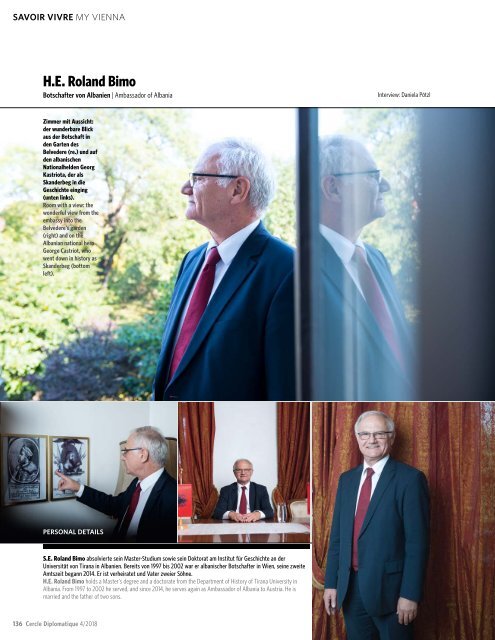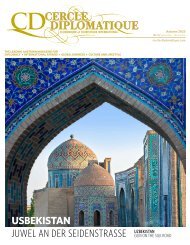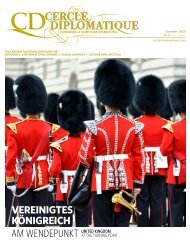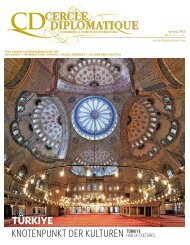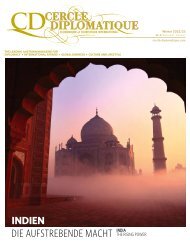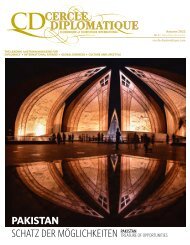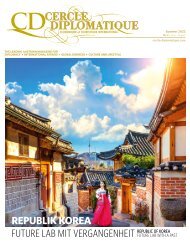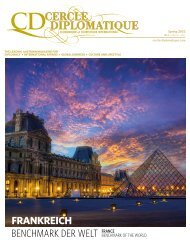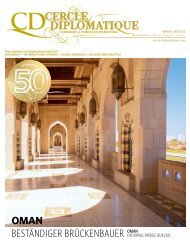CERCLE DIPLOMATIQUE - issue 04/2018
CD is an independent and impartial magazine and is the medium of communication between foreign representatives of international and UN-organisations based in Vienna and the Austrian political classes, business, culture and tourism. CD features up-to-date information about and for the diplomatic corps, international organisations, society, politics, business, tourism, fashion and culture. Furthermore CD introduces the new ambassadors in Austria and informs about designations, awards and top-events. Interviews with leading personalities, country reports from all over the world and the presentation of Austria as a host country complement the wide range oft he magazine.
CD is an independent and impartial magazine and is the medium of communication between foreign representatives of international and UN-organisations based in Vienna and the Austrian political classes, business, culture and tourism. CD features up-to-date information about and for the diplomatic corps, international organisations, society, politics, business, tourism, fashion and culture. Furthermore CD introduces the new ambassadors in Austria and informs about designations, awards and top-events. Interviews with leading personalities, country reports from all over the world and the presentation of Austria as a host country complement the wide range oft he magazine.
Create successful ePaper yourself
Turn your PDF publications into a flip-book with our unique Google optimized e-Paper software.
SAVOIR VIVRE MY VIENNA<br />
H.E. Roland Bimo<br />
Botschafter von Albanien | Ambassador of Albania<br />
Interview: Daniela Pötzl<br />
Top in und um Wien |<br />
Top in and around Vienna<br />
Zimmer mit Aussicht:<br />
der wunderbare Blick<br />
aus der Botschaft in<br />
den Garten des<br />
Belvedere (re.) und auf<br />
den albanischen<br />
Nationalhelden Georg<br />
Kastriota, der als<br />
Skanderbeg in die<br />
Geschichte einging<br />
(unten links).<br />
Room with a view: the<br />
wonderful view from the<br />
embassy into the<br />
Belvedere‘s garden<br />
(right) and on the<br />
Albanian national hero<br />
George Castriot, who<br />
went down in history as<br />
Skanderbeg (bottom<br />
left).<br />
PERSONAL DETAILS<br />
PHOTOS: RALPH MANFREDA (PORTRAITS), WEINSTRASSE KREMSTAL/ RITA NEWMAN, ZENIT/WIKIPEDIA, SCHAUB-WALZER/PID<br />
Sie haben nun in Ihrer zweiten Amtszeit rund fünf<br />
Jahre in Wien gelebt. Welche Orte in der Stadt<br />
haben Sie in dieser Zeit besonders liebgewonnen?<br />
Ich lebe und arbeite im 4. Bezirk und es scheint nur<br />
natürlich, dass man mit der eigenen Nachbarschaft eine<br />
ganz besondere Beziehung entwickelt. Meine Bürofenster<br />
zum Beispiel, schauen direkt auf den Garten des Belvedere.<br />
Es ist stets aufregend, am Theresianum, der Karlskirche,<br />
dem ORF Funkhaus oder der TU Wien vorbei zu spazieren.<br />
Der erste Bezirk ist eine ganz spezielle Attraktion. Meine<br />
Lieblingsgegend dort ist jene um die Ruprechtskirche und<br />
ich liebe es, abends durch die engen Gassen des ersten<br />
Bezirks zu gehen.<br />
Was macht für Sie Wien so besonders?<br />
Das wird eine kurze Antwort - einfach alles! Wien ist die<br />
Hauptstadt einer kleinen Nation, besitzt dabei aber globale<br />
Proportionen. Es erinnert an eine riesige Weltbühne, auf<br />
der Kunst, Wissenschaft und internationale Politik um die<br />
Vorherrschaft wetteifern. Natürlich ist Wien reich an Kunst,<br />
Geschichte, Kultur und Architektur. Ich genieße das Leben<br />
mit dem Gefühl, dass jeder Tag die Gelegenheit bietet,<br />
etwas Neues zu lernen - das hält einen beschäftigt, zu<br />
arbeiten und dabei zu entdecken. Hier habe ich auch<br />
gelernt, Architektur und durch sie auch viel Geschichte zu<br />
genießen.<br />
Haben Sie einen Lieblingsort in Wien, den Sie uns<br />
verraten?<br />
Inmitten von Wiens Heldenplatz zu stehen und dabei das<br />
Rathaus, das Parlament, die Nationalbibliothek, das<br />
Weltmuseum und die Neue Burg im Kunsthistorischen<br />
Museum (KHM) zu bewundern, wo das Schwert und der<br />
Helm des albanischen Nationalhelden Skanderbeg<br />
ausgestellt sind, gibt mir ein ganz spezielles Gefühl für die<br />
Großartigkeit dieser Stadt die mir schon seit gesamt rund<br />
neun Jahren Heimat ist, da dies ja meine bereits zweite<br />
Amtszeit ist.<br />
Wenn Sie Gäste aus Ihrem Heimatland zu Besuch<br />
haben, wo führen Sie sie hin?<br />
Manche Besucher führen wir in die Staatsoper aus um<br />
Vorstellungen weltberühmter Künstler zu genießen. Viele<br />
unserer Gäste sind natürlich daran interessiert, Skanderbegs<br />
Waffen sowie die Plätze zu sehen, die Österreich und<br />
Albanien seit den beiden vergangenen Jahrhunderten<br />
verbinden. Das Stift Klosterneuburg, das Stift Göttweig und<br />
Dürnstein, alle in Niederösterreich, gehören zudem zu den<br />
oft besuchten Plätzen.<br />
Welche Erinnerungen werden Sie mitnehmen, wenn<br />
Sie Wien wieder verlassen müssen?<br />
Ich nehme viele wertvolle Freundschaften und Erinnerungen<br />
an exzellente Zusammenarbeit sowie Verständnis mit.<br />
Und zudem etwas, das der frühere US-Präsident Gerald<br />
Ford auf den Punkt brachte: „Im kulturellen, humanitären<br />
und vor allem moralischen Sinne ist Österreich am Welthorizont<br />
von großer Bedeutung, denn in den Nachkriegsjahren<br />
hat sich gezeigt, dass ein kleines Land überleben<br />
und in Frieden, Freiheit und Würde gedeihen kann. “<br />
In your second term of office, you have now lived in<br />
Vienna for almost five years. Which parts of the city<br />
have you grown particularly fond of during your time<br />
here?<br />
I live and work in the 4 th district and it seems only natural<br />
that one develops special relations with the own<br />
neighbourhood. For example, my office windows overlook<br />
Belvedere garden.<br />
It is always exciting to walk by Theresianum, Karlskirche,<br />
ORF Funkhaus or TU Wien. The first district is a special<br />
attraction itself. My favourite part is the area around St<br />
Rupert’s Church and I love walking through the narrow<br />
lanes in the first district late in the evening.<br />
In your view, what makes Vienna so unique?<br />
Short answer – everything! Vienna is a capital city of a<br />
small nation but it has global proportions. It resembles a<br />
huge world stage where art, science, international politics<br />
and much more are competing for preeminence. Of course,<br />
Vienna is so rich in art, history, culture and architecture. I<br />
enjoy living with the feeling that every day offers an<br />
opportunity to learn something new – which keeps you so<br />
busy working and discovering. Here, I have learned to enjoy<br />
architecture and through it a lot of history.<br />
Do you have a favourite place in Vienna and where is it?<br />
Standing in the middle of Vienna’s Heldenplatz and<br />
admiring the City Hall, the Parliament, Kunsthistorisches<br />
Museum, Natural History Museum, National Library,<br />
Weltmuseum, and Neue Burg at KHM, where the sword and<br />
magnificent helmet of Albania’s national hero Scanderbeg<br />
are displayed, gives me a special feeling of the greatness of<br />
the city which has been home for nearly 9 years altogether,<br />
as this is my second term of service in Vienna.<br />
When you have visitors from your home country, where<br />
do you like to take your guests?<br />
Some visitors are taken to Staatsoper to enjoy performances<br />
of famous world class artists. Most of them are<br />
interested to see the arms of Scanderbeg and places that<br />
have connect Austria and Albania for the last two<br />
centuries. Klosterneuburg Monastery, Göttweig Abbey and<br />
Dürnstein, all in Lower Austria, also belong to frequently<br />
visited places.<br />
Which memories are you going to take with you when<br />
you have to leave Vienna again?<br />
I will take with me many precious friendships and<br />
memories of excellent cooperation and understanding. One<br />
of the things I will take with me was summarised by the<br />
late US-President Gerald Ford: “In the cultural, in the<br />
humanitarian and, above all, in the moral sense, Austria<br />
looms large on the world horizon, for what in the post-war<br />
years have done to prove that it is possible for a small<br />
country to survive and to prosper in peace, freedom and<br />
dignity.”<br />
Das Stift Göttweig in Niederösterreich;<br />
der im Kunsthistorischen Museum Wien<br />
ausgestellte Helm des albanischen<br />
Nationalhelden Georg Kastriota und die<br />
Ruprechtskirche im 1. Wiener Bezirk (von<br />
oben nach unten).<br />
Göttweig Abbey in Lower Austria; the<br />
helmet of the Albanian national hero<br />
George Castriot, displayed at Kunsthistorisches<br />
Museum Wien and St Rupert‘s<br />
Church in Vienna‘s first district (from top to<br />
bottom).<br />
S.E. Roland Bimo absolvierte sein Master-Studium sowie sein Doktorat am Institut für Geschichte an der<br />
Universität von Tirana in Albanien. Bereits von 1997 bis 2002 war er albanischer Botschafter in Wien, seine zweite<br />
Amtszeit begann 2014. Er ist verheiratet und Vater zweier Söhne.<br />
H.E. Roland Bimo holds a Master‘s degree and a doctorate from the Department of History of Tirana University in<br />
Albania. From 1997 to 2002 he served, and since 2014, he serves again as Ambassador of Albania to Austria. He is<br />
married and the father of two sons.<br />
136 Cercle Diplomatique 4/<strong>2018</strong><br />
Cercle Diplomatique 4/<strong>2018</strong> 137


